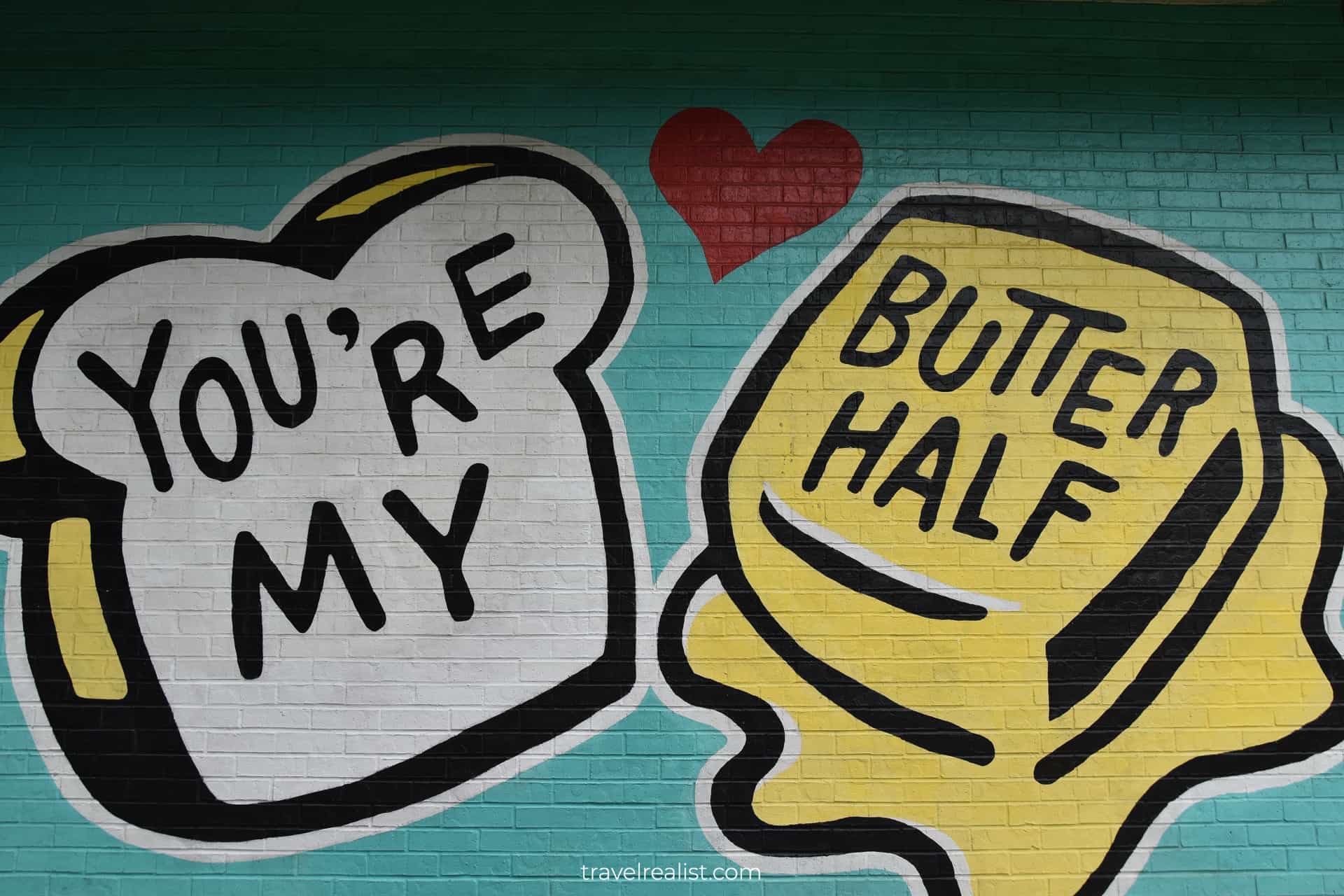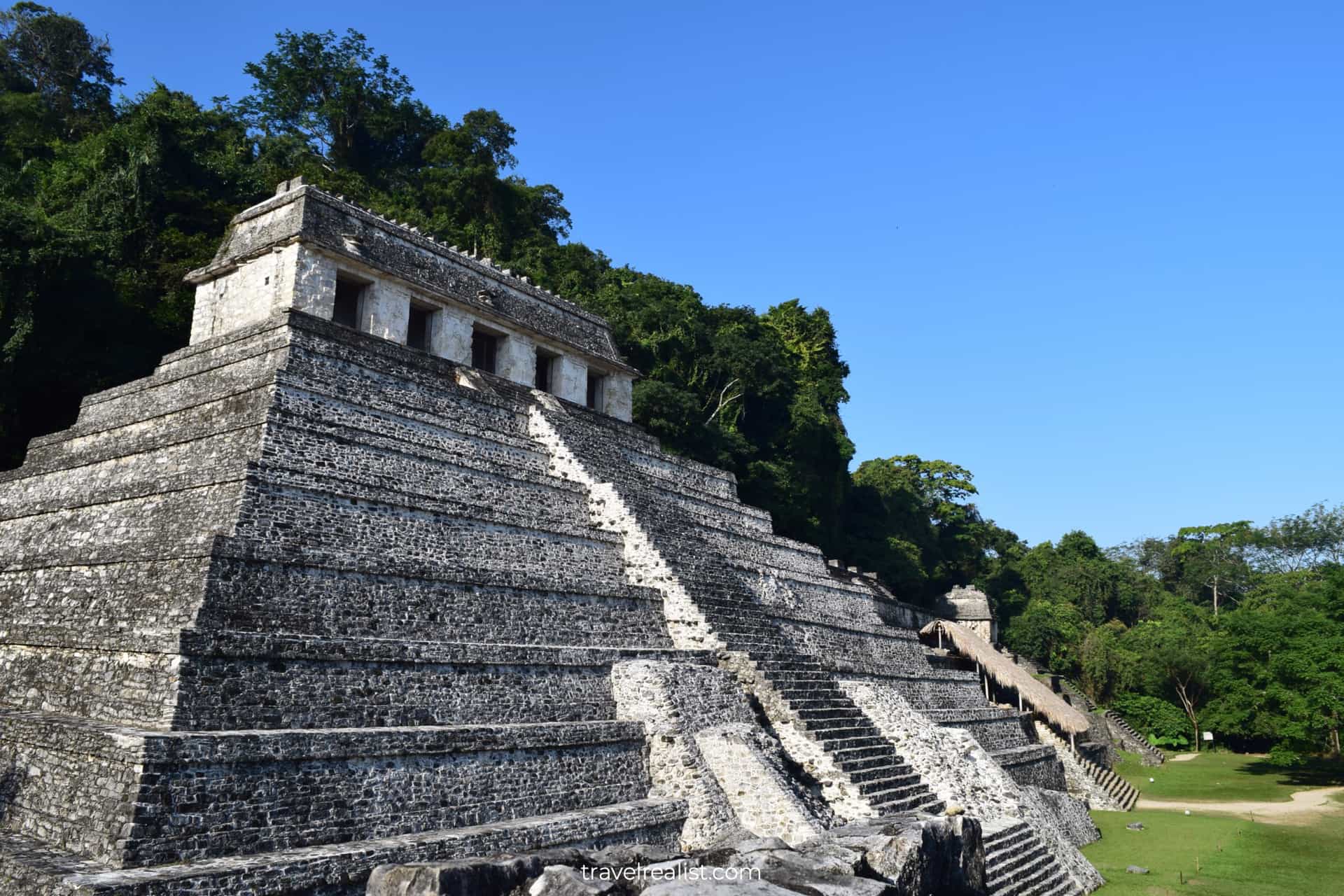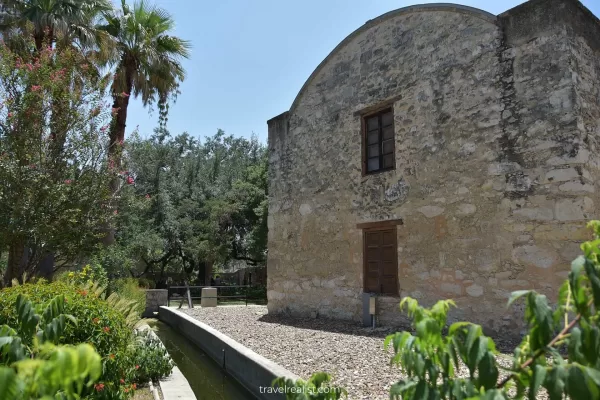Balls Falls Conservation Area: Waterfalls and Historic Village
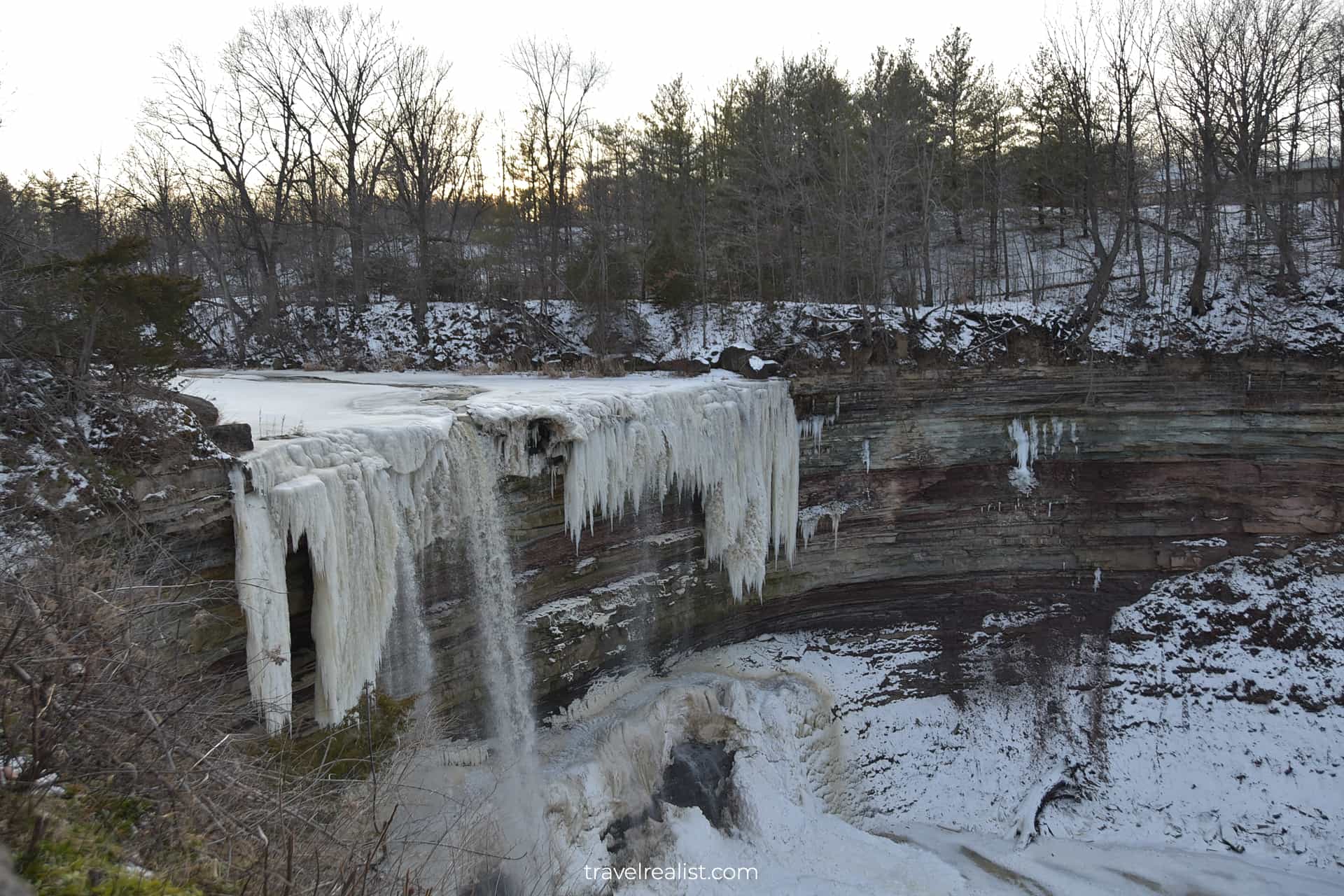
This realistic Balls Falls Conservation Area Guide helps you plan your next winter adventure in this park.
Balls Falls Conservation Area is a park that consists of two waterfalls and a historic village along the creek. It is a hidden gem on Niagara Peninsula in Ontario, Canada.
This post includes affiliate links that will earn us commission if you make a purchase via these links.
Sights & Places of Interest
Balls Falls Conservation Area has been a park since 1962. But the estate dates back to the early 19th century. The first buildings has been on this property since 1807.
The park staff worked hard to preserve and restore these historic buildings. The goal of this effort is simple. You should have a chance to see Balls Falls as close to its original state as possible.
This Balls Falls Conservation Area Guide covers the key sights in this park. Read on to learn more about a visit to Lower and Upper Falls and the historic village in the winter.
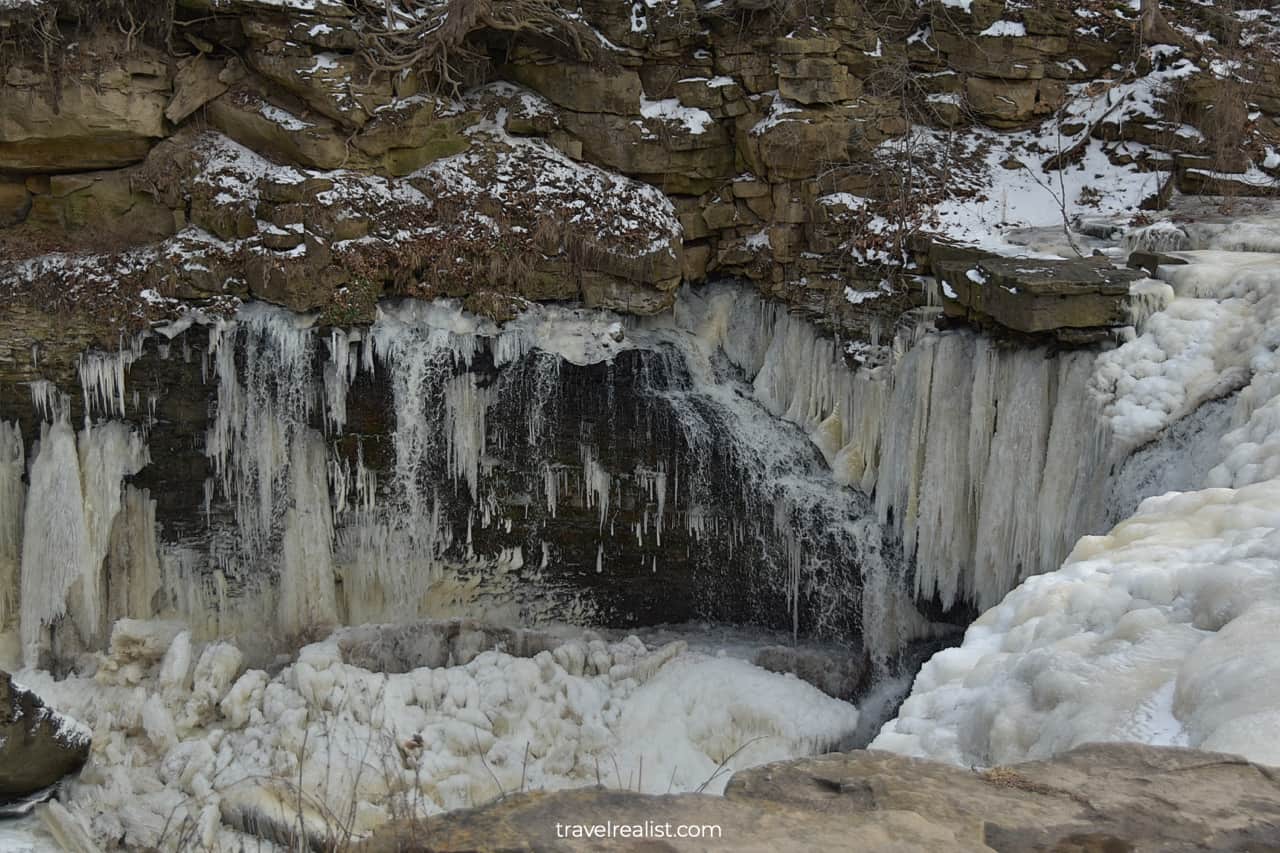
1. Center for Conservation
Your visit to Balls Falls Conservation Area will likely start at the Center for Conservation. It is a large building next to the main parking lot.
There might not be a person on duty if you visit Balls Falls in the winter. But the Center should still be open between 9 a.m. and 4 p.m. You could use the amenities and study the exhibits at your own pace.
The Center for Conservation is a starting point for most hiking trails in the park. You could choose from three easy to moderate trails and one longer, more difficult trail:
- Switch Back Trail: a 0.4-mi (0.7-km) loop that connects the next two trails.
- Cataract Trail: a 2-mi (3-km) out-and-back trail to Lower and Upper Falls.
- Forest Frolic Trail: a 0.5-mi (0.9-km) loop trail.
- Bruce Trail: a 6.5-mi (10-km) out-and-back trail.
This Balls Falls Conservation Area Guide follows a path on the Switch Back and Cataract Trails. You will first see the Historic Village and Lower Falls before hiking to Upper Falls.

2. Twenty Mile Creek
The Switch Back Trail to the village and falls goes downhill. While it is great news in the summer, a downhill hike could present issues in the winter. Take your time since the trail could have snow and ice.
You will reach an intersection with the Cataract Trail in about 10 minutes. Turn left to reach Lower Falls. You will start hiking along Twenty Mile Creek soon.
This creek circles through the region before flowing into Lake Ontario a few miles (km) north from Balls Falls. Both Upper and Lower Falls are on this creek.
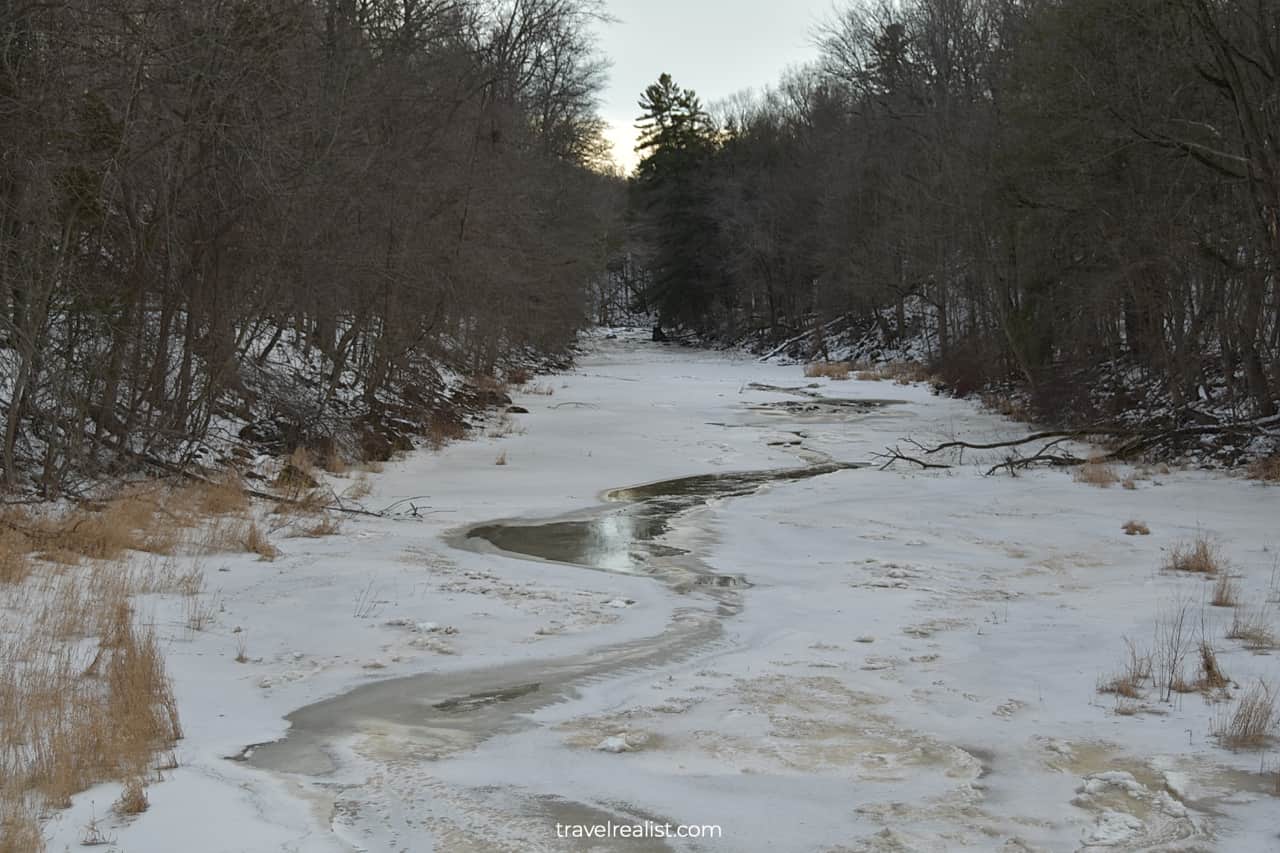
A winter visit to Balls Falls will reveal a partially frozen creek. Unless there was a cold front for weeks before your visit, some parts of the creek will not have ice.
Even the sections that appear frozen, might be weak. Therefore, it is not a good idea to approach Twenty Mile Creek in the winter. Just stay onshore and admire this wintry landscape from a safe distance.
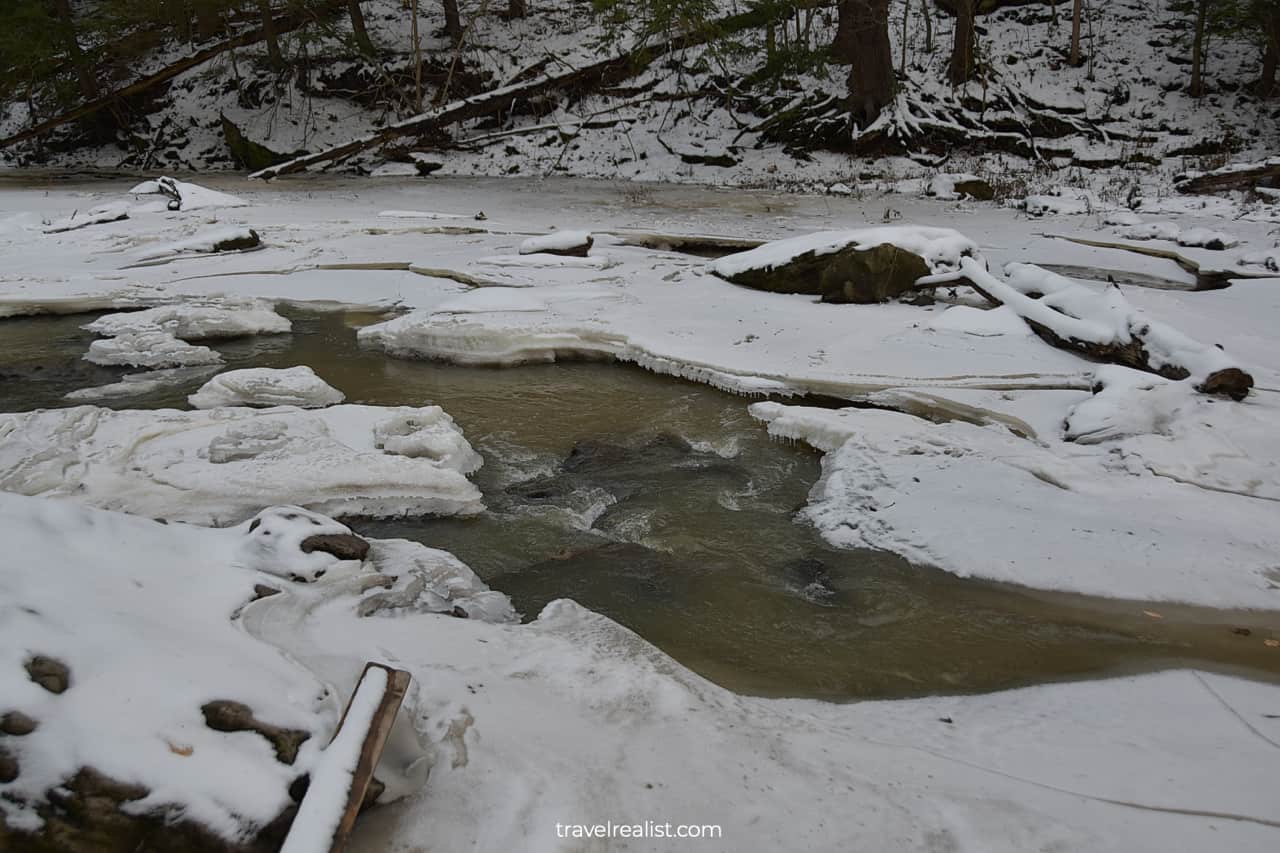
3. Pedestrian Bridge
The Cataract Trail will bring you to a pedestrian bridge in just a few minutes. This bridge provides hikers with a safe passage to the other side of Twenty Mile Creek.
You could also use another bridge. It is a few hundred feet (meters) downstream. Just keep in mind that the other bridge is a road bridge. You would have to share it with other hikers, bikers, and cars.
The Pedestrian Bridge could have decorations for the annual Holiday Trail. The park staff puts lights and other decorations throughout the park before the holiday season.
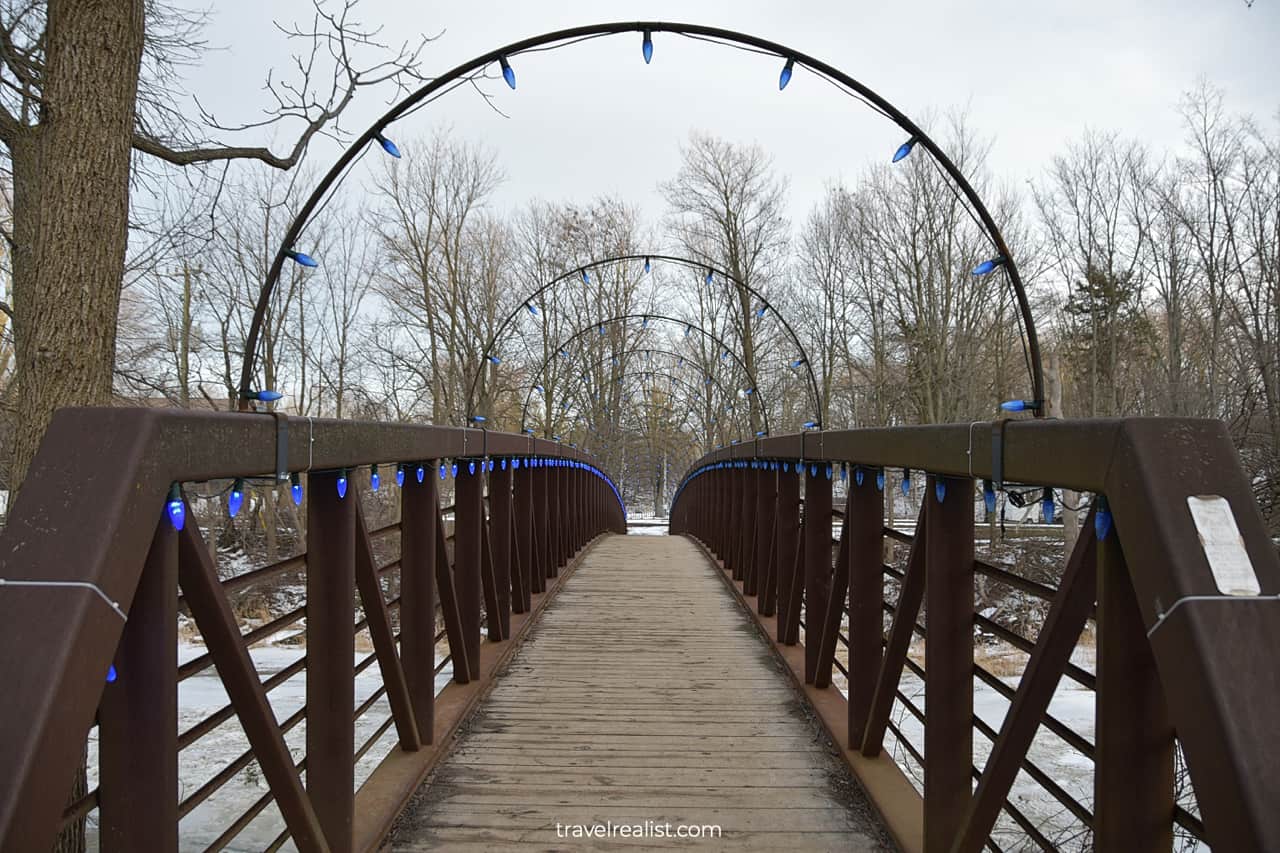
4. Ball Home
You will see a barn and a special permit parking once you cross the bridge to the other side. This building is not open to the public. Keep walking on the Cataract Trail until Sixth Avenue.
You need to cross this street to explore the Historic Village on the other side. There are a few paths you could take through the village. But the fastest one brings you past the Ball Home.
The Ball Home is the main building in Balls Falls Conservation Area. The two story red brick mansion was a home of the Balls family. It dates back to the early 19th century.
The house became a museum in the 20th century when Niagara Peninsula Conservation Authority purchased this land. The park offers guided tours of the home. The schedule depends on the season.
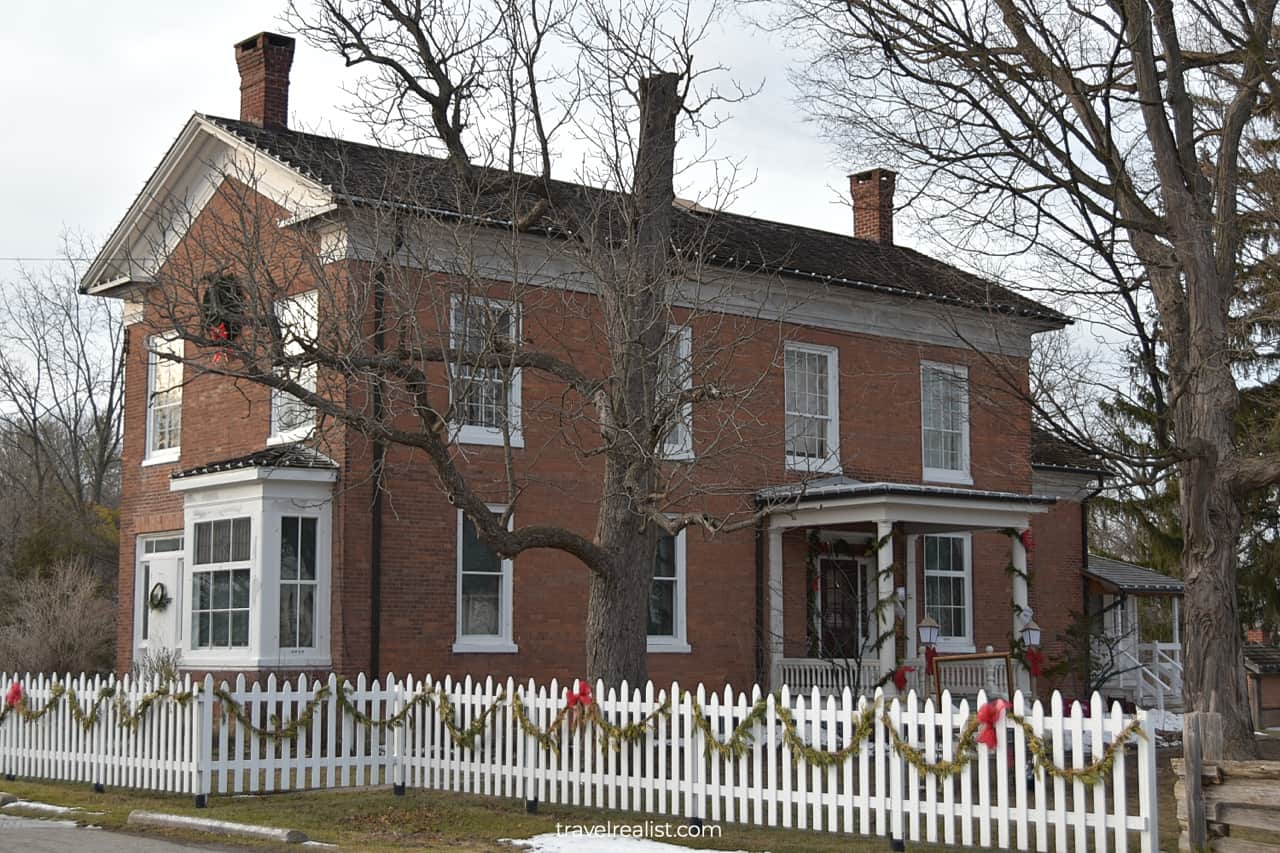
5. Church
You will see a church across the lawn from the Ball Home. This white wooden building has been restored after the land became a conservation area.
The church has beautiful stained glass windows. You are welcome to go inside and see them at your pace. No guide is needed to enter this building.
This part of Balls Falls looks a lot like Waterloo Village in New Jersey. Both villages date back to about the same period. But Waterloo Village has buildings from a few families rather than just one.
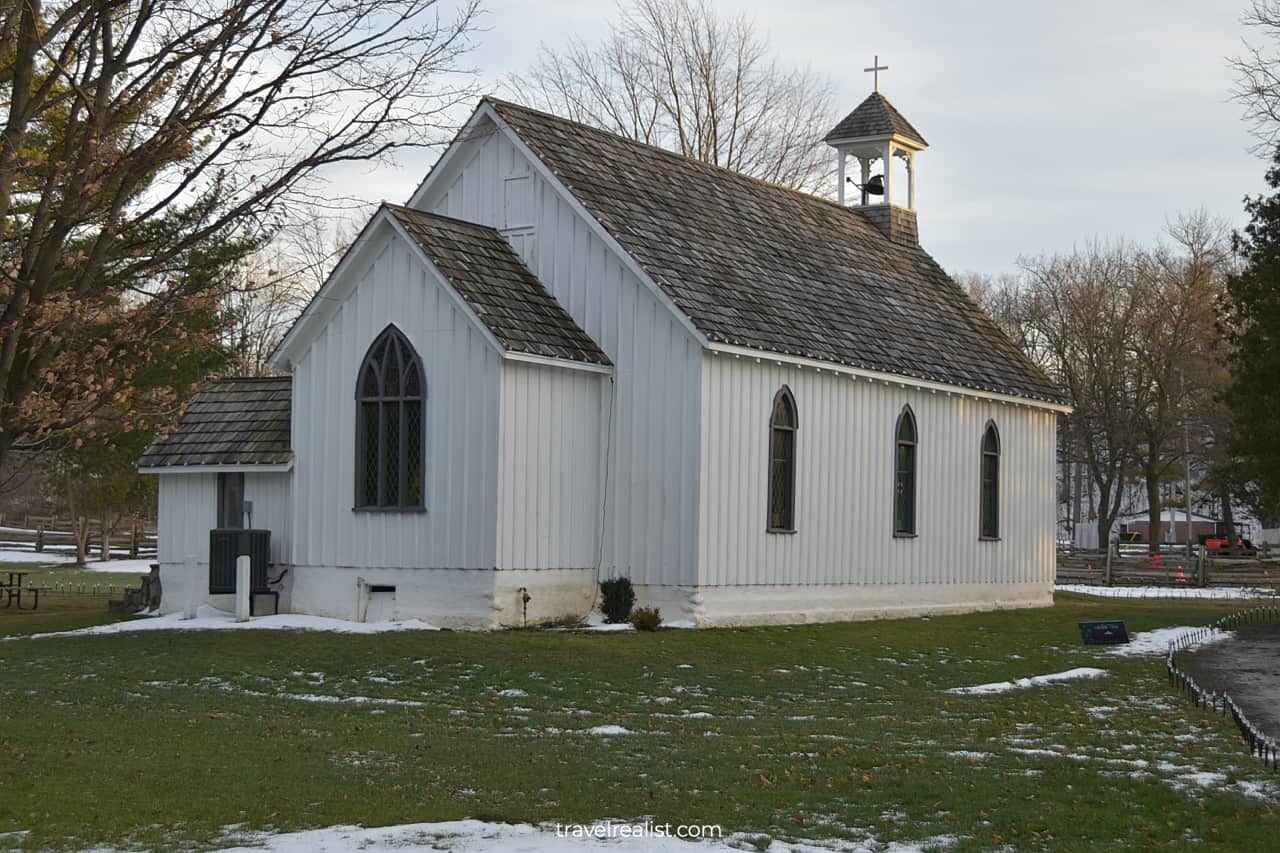
6. Sheds
The area between the Ball Home and the Church has a few sheds. There is a fruit drying shed and a carriage shed. You could also find a bake oven between the sheds and the house.
All of these structures are closed to the public. You could only explore them from the outside. It is also possible that the guides cover them in more depth during the Ball Home tour.
The park often uses this area for decorations and exhibits on the Holiday Trail. You could spend a little more time there taking pictures.
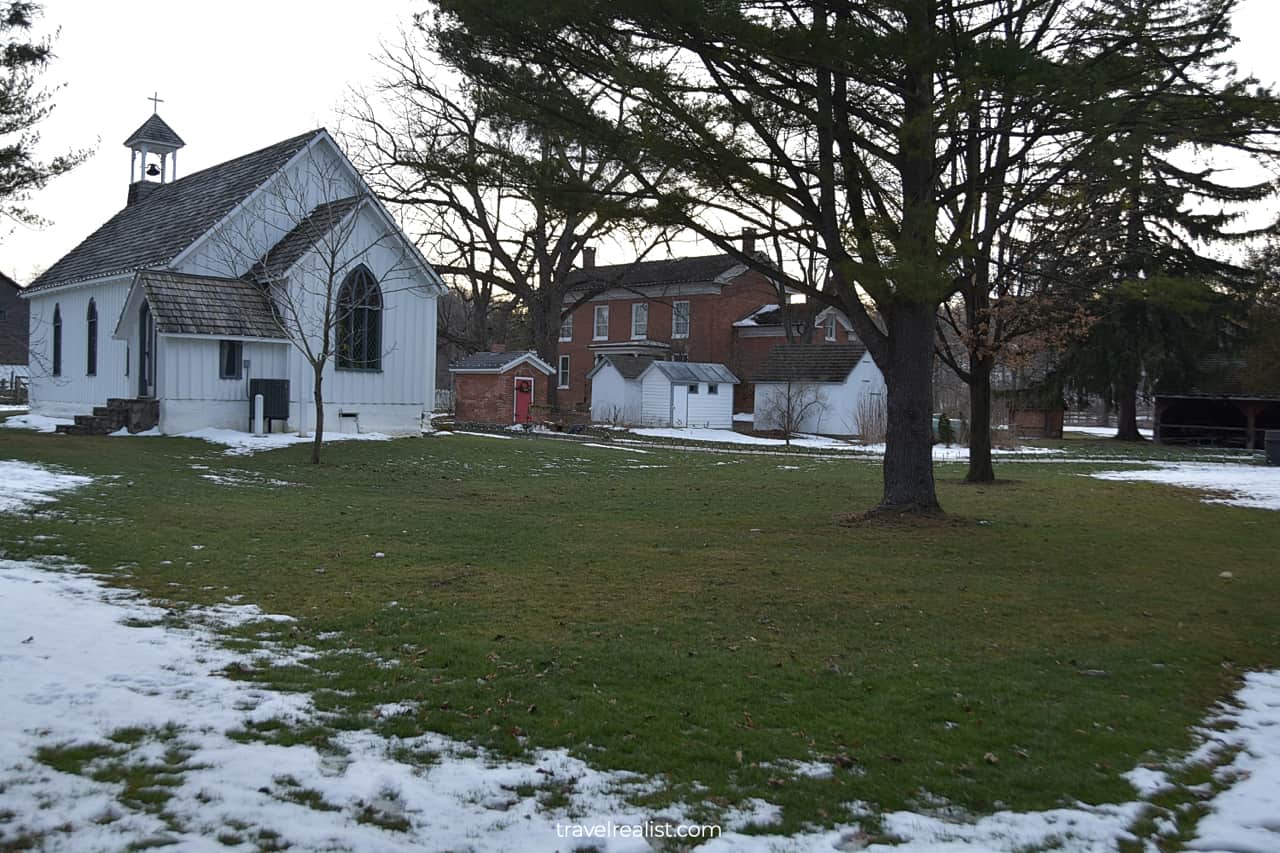
7. Display Barn
You do not need a guide to see the next building in the historic village. It is open to the public for a self-paced exploration. The name of the building says it all: the park wants you to check out the Display Barn.
It is a large grey wooden building with a forged weather vane on the roof. The exterior of the Barn is quite common among the farm warehouse buildings throughout the continent.
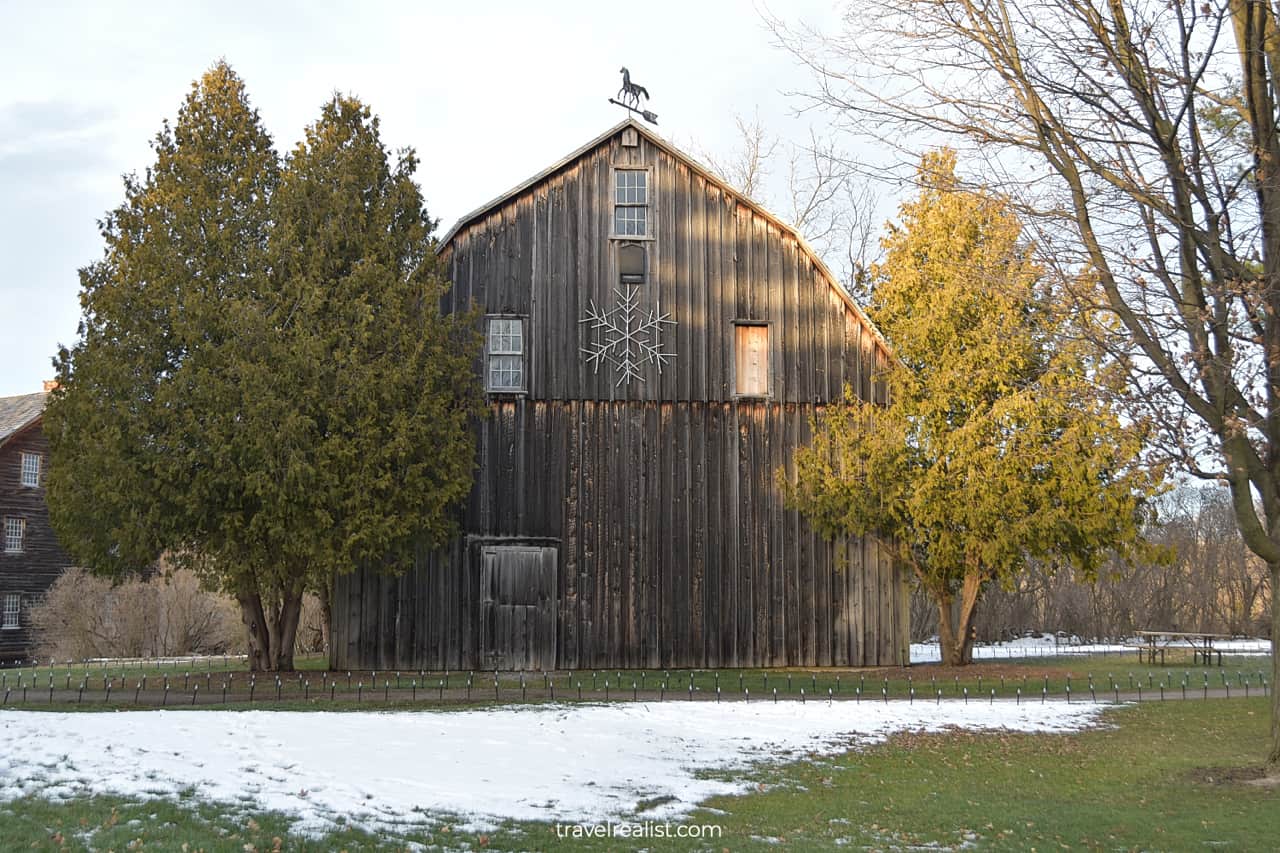
There are a lot of things to see inside the Display Barn. Old carriages, tools, and signs await the curious visitors. The carriages came back from the Carriage Shed nearby.
There are massive doors on both sides of the Display Barn. They remain open during the park hours. While the open doors are inviting, they create a draft. It could often feel colder inside than outdoors.
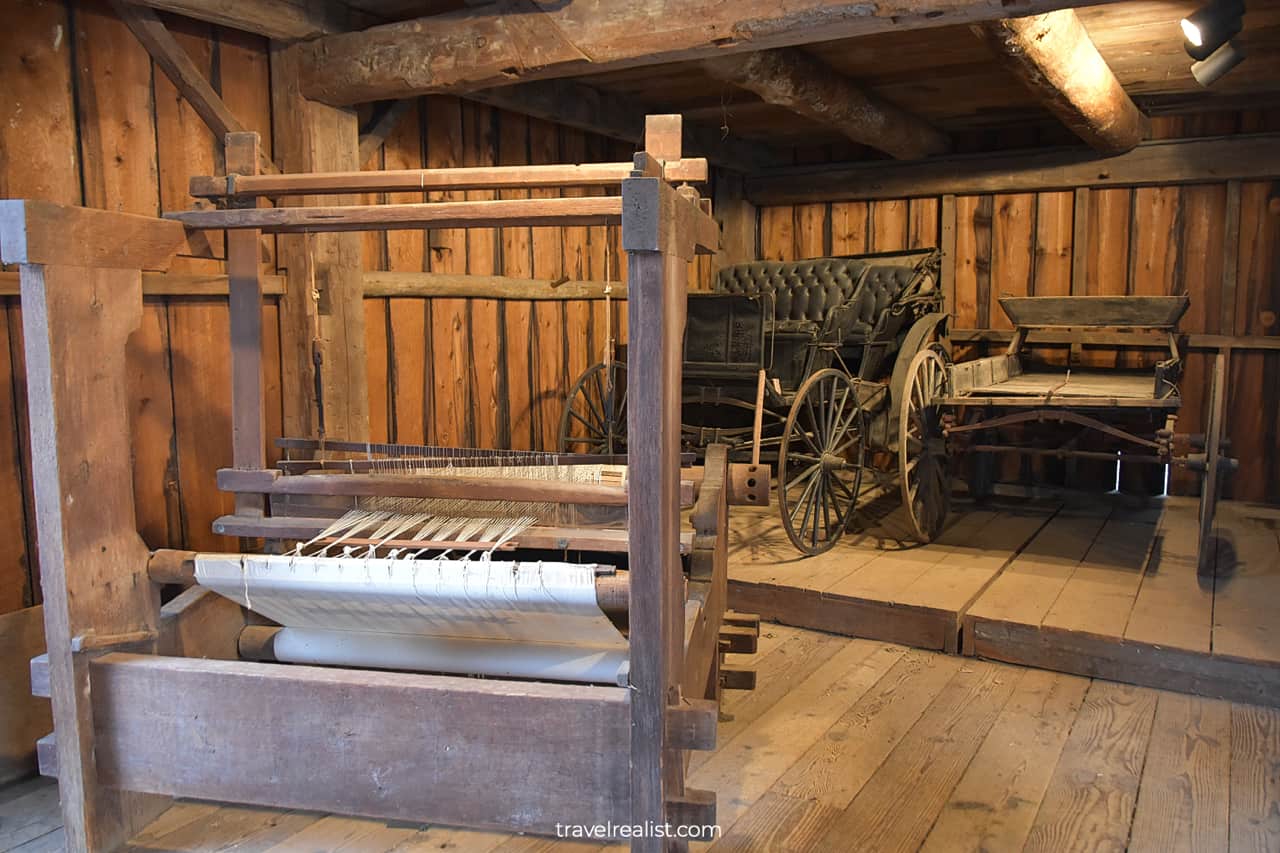
8. Grist Mill
The Grist Mill is the nearest structure to the Display Barn. It is a two story wooden building with a mesh door. You could get a sense of the building interior by looking through the door.
This mill is still operational. But the building is off limits to the visitors except on the guided tour of the Ball Home. This is the only way to see the Grist Mill at Balls Falls in action.
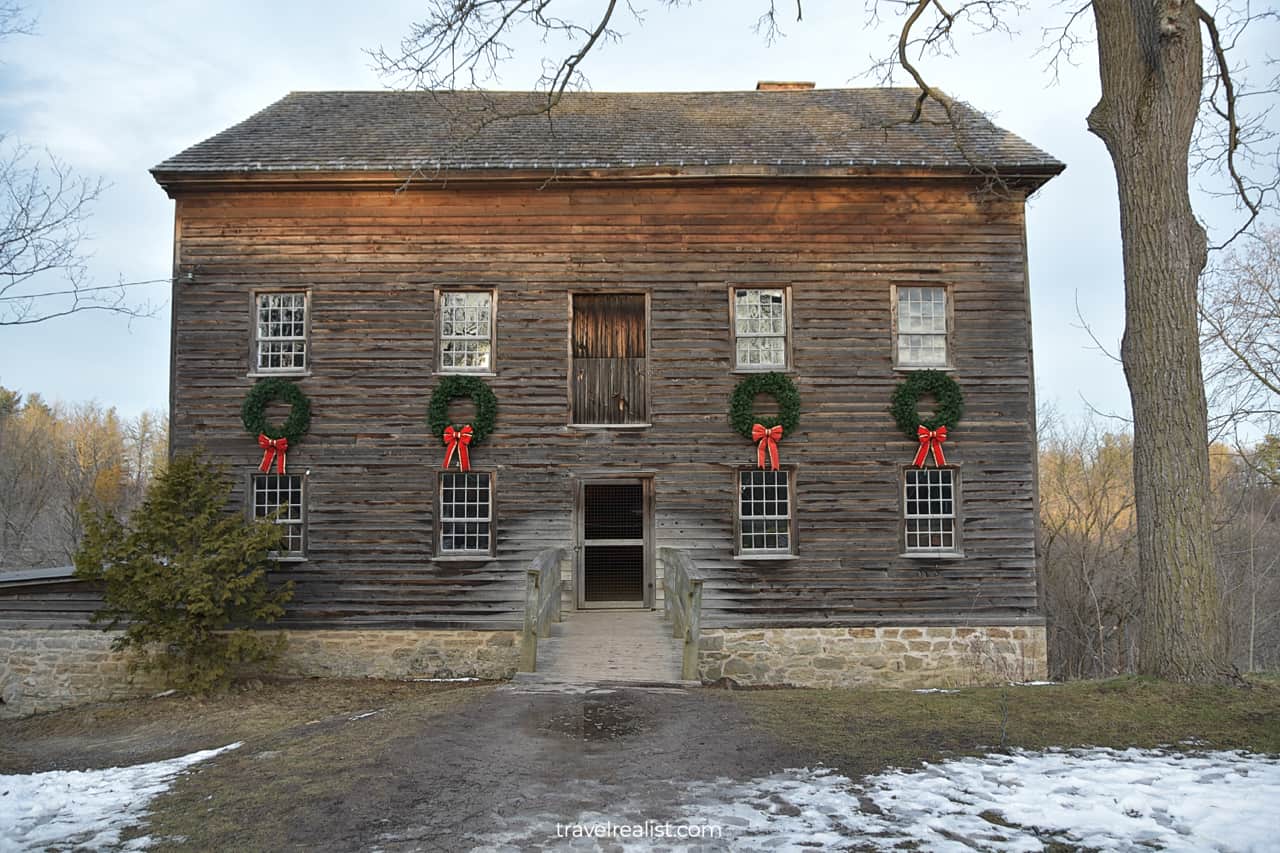
9. Lower Falls
The Grist Mill, like any 19th century mill, needs water to function. It means that you are close to Twenty Mile Creek. In fact, Lower Falls are also just around the corner.
The Cataract Trail brings you to another pedestrian bridge. This bridge looks just like a boardwalk over a swamp. You will arrive at a viewpoint as soon as you step off the boardwalk.
Lower Ball’s Falls will be on full display. This 90-ft (27-m) waterfall is very pretty. But winter is the worst time to see these falls. Less water is flowing since parts of Twenty Mile Creek freeze upstream.
Do not count on admiring a powerful stream in the winter. As a consolation you will see impressive icicles. They will be hanging from the crest of the waterfall down into the gorge.
The gorge looks a bit like Starved Rock near Chicago, Illinois. This is hardly a surprise. Balls Falls and Starved Rock are in the same region of the Great Lakes. It spans across the U.S. and Canada.
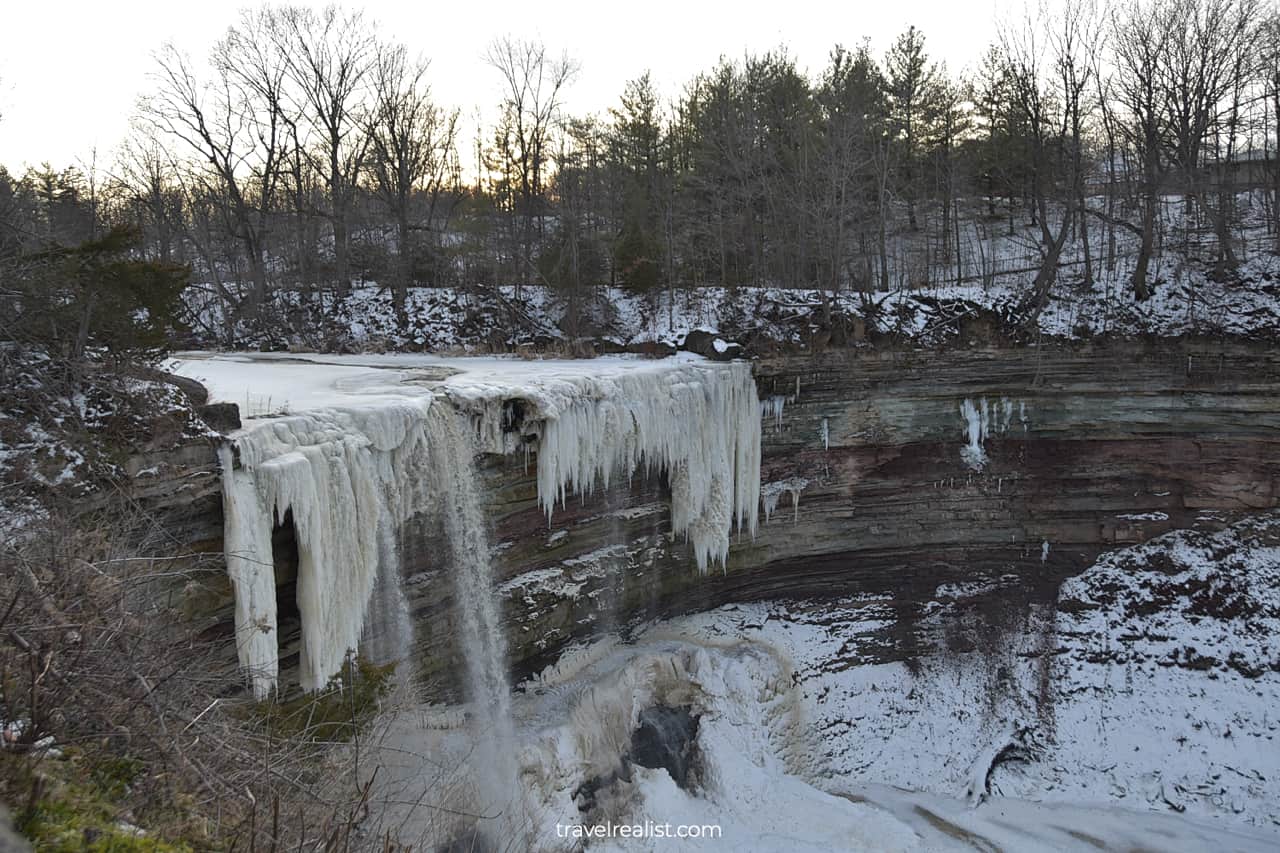
10. Cataract Trail
After visiting Lower Falls, you could continue exploring the historic village. While there are other buildings in the village, they are all closed to the public.
You could still stop by a blacksmith shop, two cabins, and lime kiln ruins. They give you a better idea of what life looked like in Balls Falls in the 19th and 20th centuries.
Once you explore these buildings from the outside, there will be no more structures to see in the village. It could be a good time to start your 0.6-mi (0.9-km) hike to Upper Falls.
You would first need to return via the same path. Cross Sixth Avenue and Twenty Mile Creek via a pedestrian bridge. Then you need to follow the creek until you reach the falls.
This trail is sure to have some snow in the winter. There are a few reasons. The trail to Upper Falls is longer. Fewer people hike that far. And this section of the Cataract Trail is not part of the Holiday Trail.
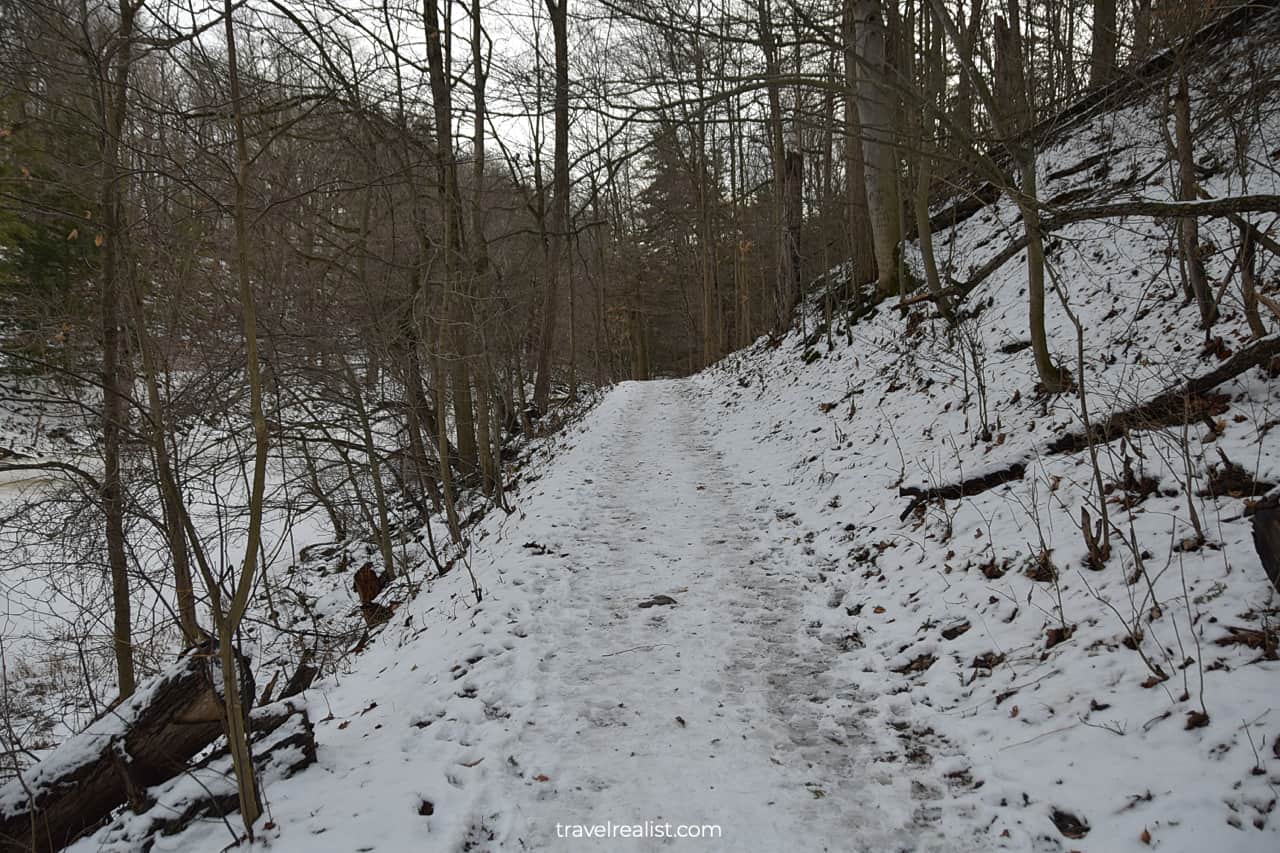
11. Woolen Mill Ruins
The trail gradually gains elevation as you hike upstream. You are looking at a total gain of 102 ft (31 m) by the time you reach the falls viewpoint.
Hiking on snow is already a difficult task. An uphill or downhill hike on a snowy path presents even more dangers. Do not rush as you are hiking this trail. A winter slip and fall injury is the last thing you need.
There will be no landmarks during most of the trail. You will be hiking in a forest next to a frozen creek. Things will change a bit right before the falls viewpoint. You will arrive at the Woolen Mill Ruins.
There is a small information board next to the ruins. Without it, it is quite difficult to guess the function of these stone ruins. They could have been anything from a fort to a house.
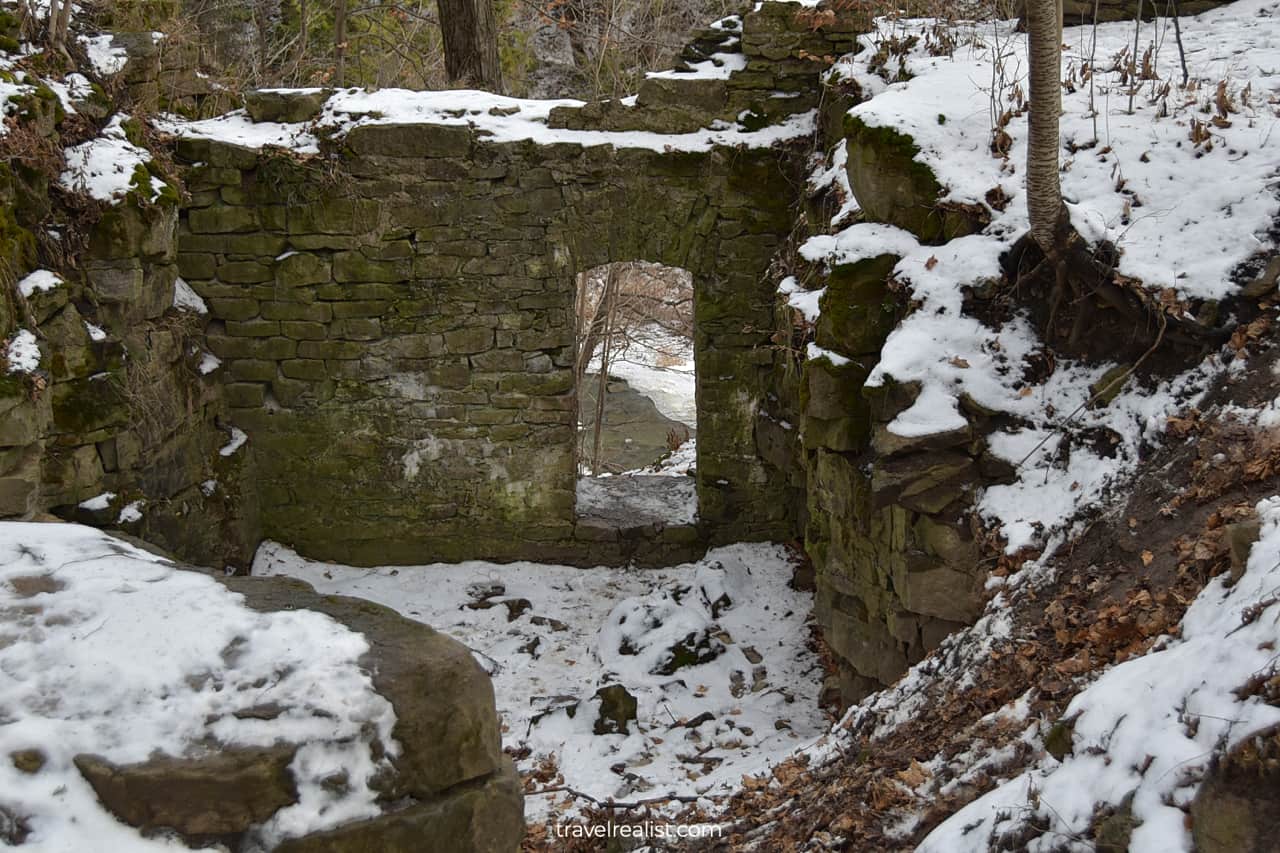
12. Upper Falls
Upper Falls are within reach once you pass the Woolen Mill Ruins. You are within your right to expect another beautiful waterfall after stunning Lower Falls.
But it is better to manage your expectations. Upper Falls are much shorter than Lower Falls. They only drop 35 ft (11 m). This waterfall is also at an angle to the Lookout.
You will get a better look of the steep cliffs on the other side of Twenty Mile Creek. There is a lot to see there. Tall trees are growing on top of solid rock next to a cliff edge.
A few of the trees have exposed roots. They might fall down into the gorge after a heavy storm or under the weight of snow.
Down below you will get another icicle display. There are columns of ice that connect the creek bed with the crest of the falls. Still, there is some water flowing below and behind the ice.
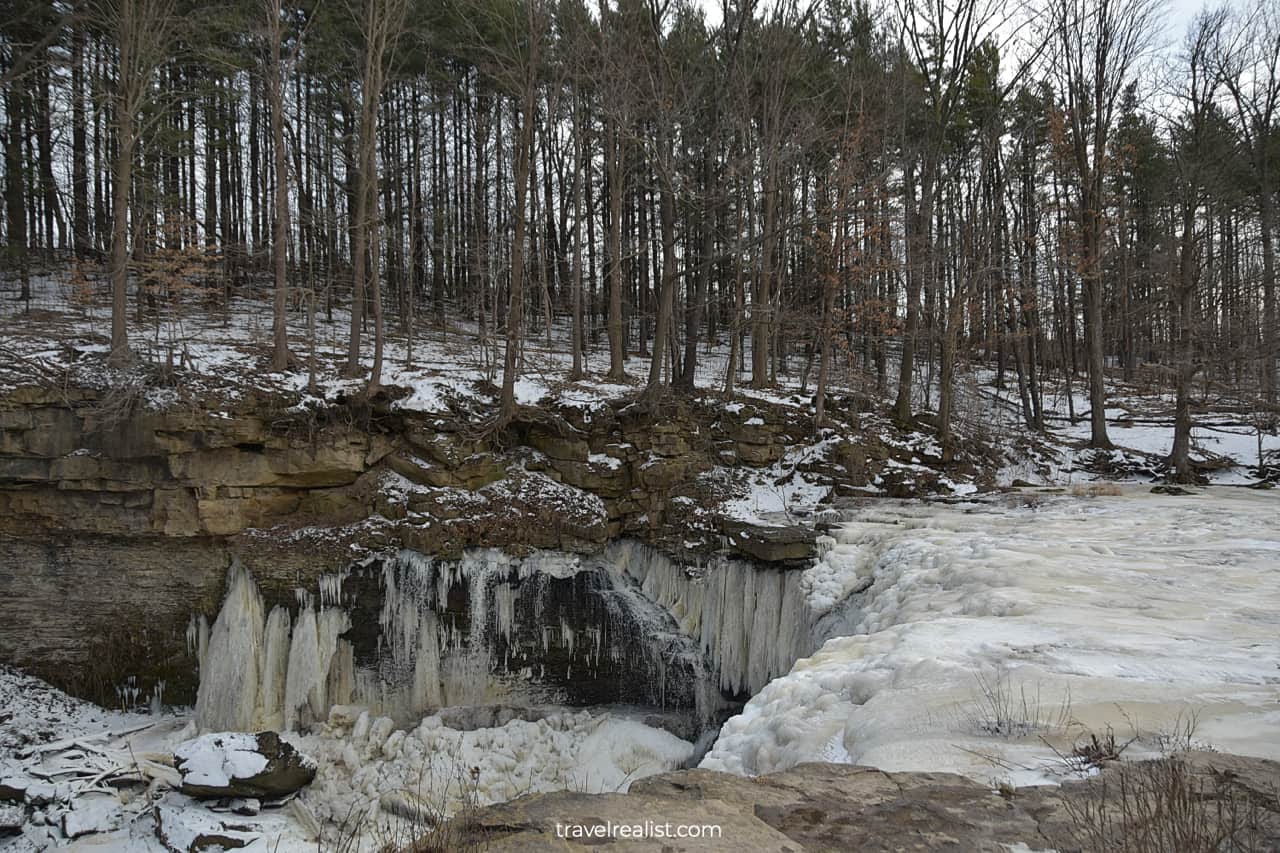
The Upper Falls viewpoint is near the park boundary. You could only get a glimpse of Twenty Mile Creek flowing upstream from the falls.
Just as with Lower Falls, you would need to take the Cataract Trail back to the Center for Conservation. You could choose a different trail path on your way back. This path goes further away from the creek.
This path avoids an uphill climb at the Switch Back Trail. It is the fastest and easiest path back to the parking lot. Still, even fewer people take it in the winter. You will be hiking in the snow on this path.
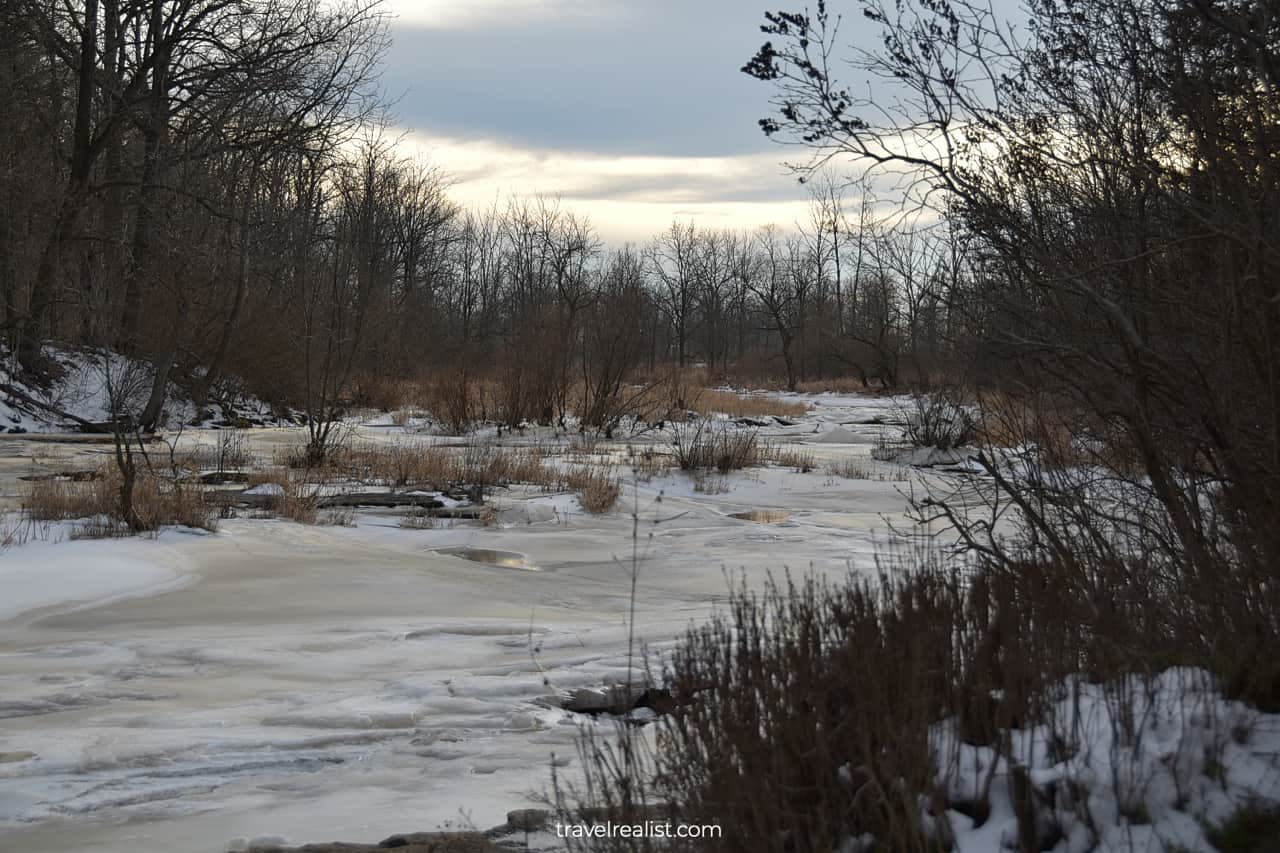
Continue with this Balls Falls Conservation Area Guide. You will learn more about ways to get to the sights, entrance requirements, and places to stay.
Getting to Balls Falls Conservation Area
Balls Falls Conservation Area is a park on Niagara Peninsula in Ontario, Canada. The park is a 20-minute drive west from St. Catharines, Ontario.
Balls Falls is just 4 miles (6 km) from Queen Elizabeth Highway, the major highway in this region. It is the main route that connects Buffalo, New York with Toronto, Ontario.
A car is the only option to reach Balls Falls. There are no trains or buses that stop near the park. The closest train station is in St. Catharines. You would still need a car for the last 9 miles (14 km) to the park.
If you are traveling from afar to see Balls Falls, consider flying to the Toronto area airports. Toronto Pearson (YYZ) is the biggest hub of all. It is 63 miles (101 km) north of Balls Falls.
Billy Bishop Toronto City (YTZ) is a smaller regional airport. It is about the same distance from the park as Toronto Pearson. But you need to take a ferry to go from the airport to the mainland.
John C. Munro Hamilton (YHM) is the closest airport to Balls Falls. It is a base for low cost airlines. While there are flights to Mexico and Iceland, there might not be a direct flight to your destination.
Balls Falls is less than 25 miles (40 km) from the Rainbow Bridge, the border between the U.S. and Canada. You could consider flying to Buffalo Niagara (BUF) airport.
Clearing the border would add some time to your journey. But the distance between the airport and the park is just 49 miles (79 km).
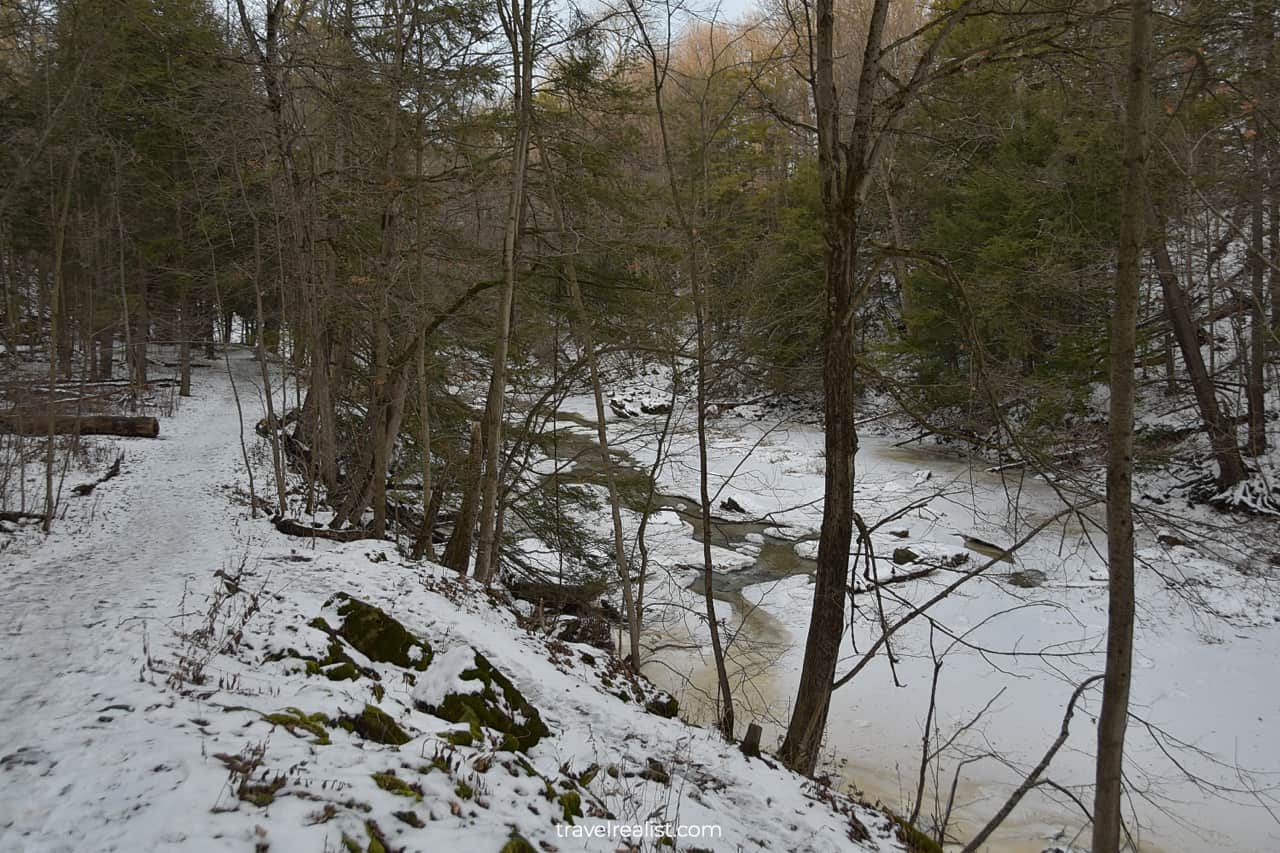
Where to Stay near Balls Falls
You are in luck if you are looking for a place to stay next to Balls Falls Conservation Area. Jordan House Hotel is just 5 minutes down the street from the park.
Other places to stay require a longer drive from Balls Falls. You should consider St. Catharines, Ontario and Niagara Falls, Ontario. Both towns have a good number of places to stay.
The former is closer to Balls Falls and has nicer places to stay. You should check out Hampton Inn St. Catharines Niagara and Holiday Inn Express Niagara-On-The-Lake, an IHG Hotel.
Niagara Falls has more places to stay but is further east from the park. You also have to compete with the visitors coming to the area to admire Niagara Falls.
But do not discount Niagara Falls if this town works out better with your trip plan. Take a look at Cannery Lofts Niagara and Serene Niagara Inn. Both places to stay are not your typical hotels.
Further west, you would need to drive all the way to Hamilton, Ontario to find nice places to stay. C Hotel by Carmen’s, BW Premier Collection and TownePlace Suites by Marriott Hamilton are solid options.
It might be a good idea to look for places to stay in the broader Toronto area. Burlington, Oakville, and Mississauga have plenty of options.
You should consider Holiday Inn & Suites Oakville at Bronte, an IHG Hotel and Home2 Suites By Hilton Toronto/Brampton, On. These hotels work best if you plan on exploring the sights in Toronto next.
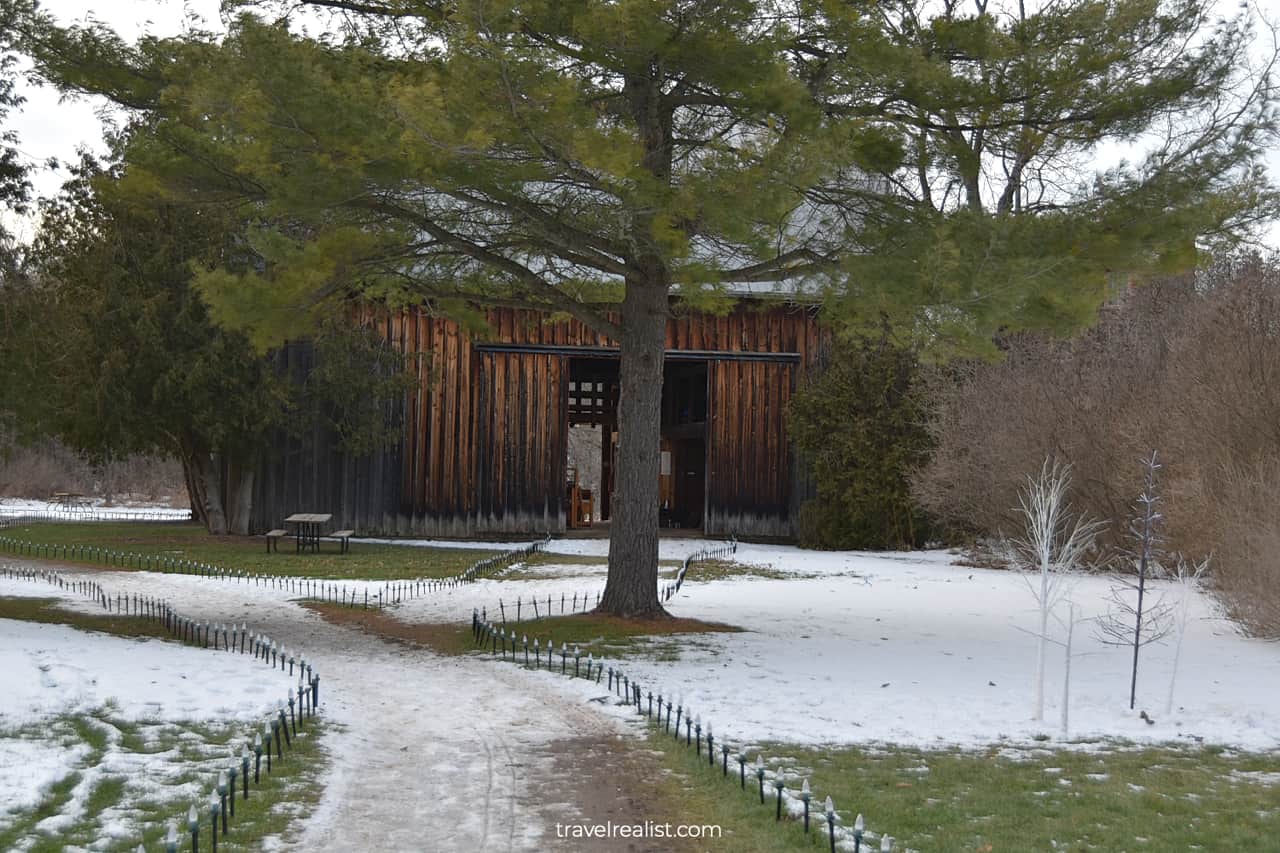
Entrance Requirements & Passes
Balls Falls Conservation Area is open every day from sunrise to sunset. The Center for Conservation has shorter hours. You could visit it between 9 a.m. and 4 p.m. daily.
Balls Falls is a Conservation Area. While provincial parks in Ontario, Canada tend to be free, conservation areas often charge admission fees. Balls Falls is no different.
The slightly less common fact is that the admission fees differ by the time of the year. You will pay more to visit Balls Falls in the spring and summer. Late fall and winter are the cheapest times to explore.
You will pay $13.75 CAD (~$10 USD) per car with an adult driver in the summer. Each additional adult passenger costs $4.75 CAD (~$3.5 USD). The maximum per car is $28 CAD (~$21 USD).
There are discounts for students and seniors. You could save $3.5 CAD (~$2.5 USD) as a driver and $1 CAD ($0.75 USD) as a passenger. The maximum charge per car is the same.
If you visit the park in the off season, you will pay just $8.5 CAD (~$6.25 USD) per car. It does not matter how many people travel with you.
There might be no staff members in the Center for Conservation. In this case, you need to pay the parking fee at the gate when exiting.
The machine might have difficulty operating if the temperatures are well below freezing. Give it some time and it should come through.
There is an annual pass to Niagara Peninsula Conservation Authority (NPCA) parks. But unless you visit the area a lot, you will not break even on $127.13 CAD (~$93.5 USD) pass.
This is higher than America the Beautiful annual pass. But the U.S. pass gives you access to all national parks in the country, not in just one region.
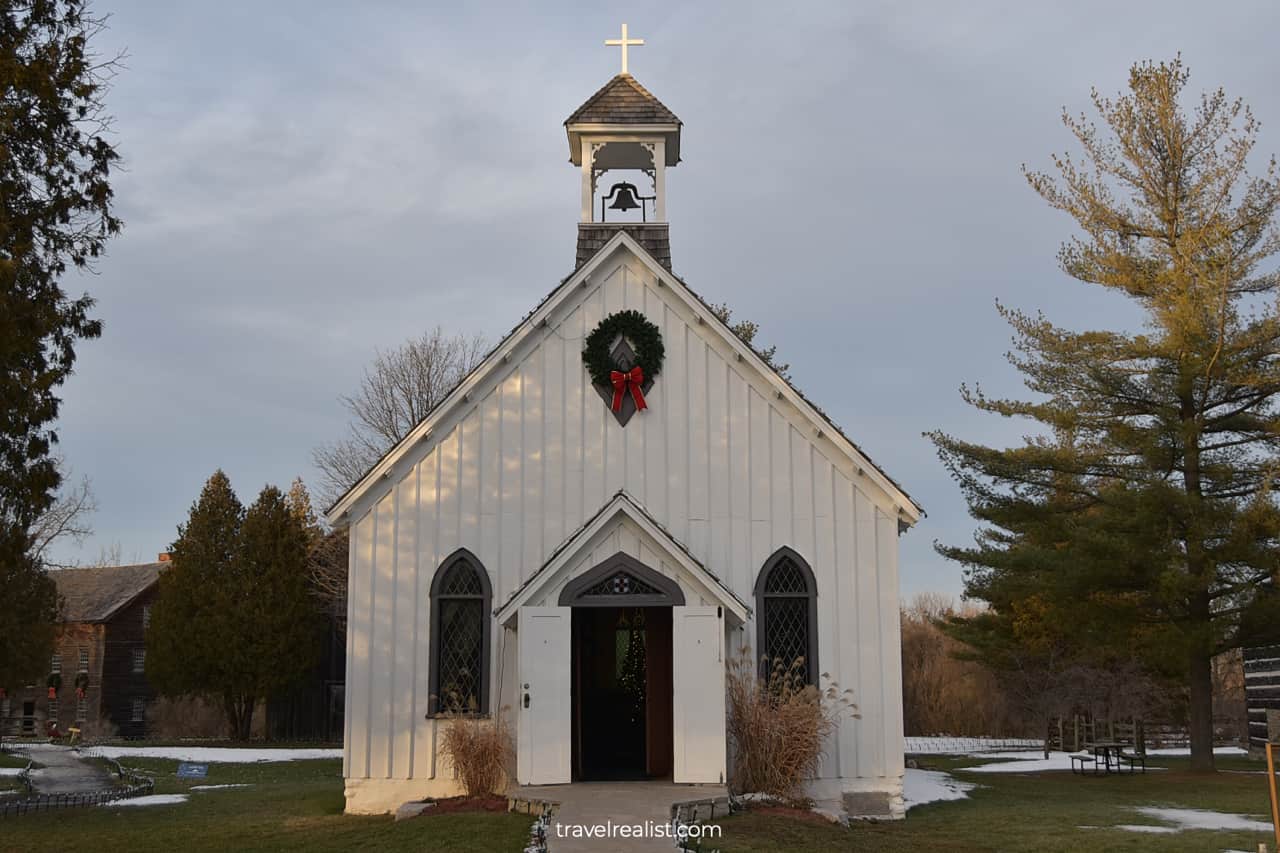
Takeaways: Balls Falls Conservation Area
Balls Falls is a nice attraction to explore in Ontario. This park is worth a 15 minute round trip drive from Queen Elizabeth Highway.
Two scenic waterfalls, a serene creek, and a historic village are great reasons for a visit. Easy to moderate trails with a bit of elevation gain connect all the sights in the park.
Stop by the Display Barn to see the original items and learn about the local crafts. Admire the stained glass windows in the restored Church. Or join a guided tour of the Ball Home.
If you are driving from Niagara Falls to Hamilton or Toronto, Balls Falls is a good addition to your trip. You would need about 90 minutes to explore the village and hike to both falls.
Seasons matter when visiting Balls Falls. You could walk the Holiday Trail if you stop by the park in the winter. But fall is a better time to visit Balls Falls. You would pay just one fourth of a summer price.
Take a look at this Balls Falls Conservation Area Video Guide. And visit the YouTube channel for the latest videos.
Frequently Asked Questions
Balls Falls Conservation Area is a scenic park in Lincoln, Ontario. There is a surprisingly long list of things to do in this park:
– Enjoy a 90-ft high drop of Lower Falls
– Stop by the Display Barn to see historic items first hand
– See the Grist Mill in operation
– Take a guided tour of the Balls Home
– Hike along Twenty Mile Creek for a few miles
– Explore the Woolen Mill Ruins
– See trees that grow on cliff edge at Upper Falls
– Walk the Holiday Trail in the winter
– See snowy forest, spring blossom, and fall foliage
There are a few great places to stay within a short drive from Balls Falls.
– Jordan House Hotel: a boutique hotel; 5-minute drive
– Hampton Inn St. Catharines Niagara: an amazing chain hotel; 17-minute drive
– Holiday Inn Express Niagara-On-The-Lake, an IHG Hotel: great choice; 25-minute drive
– Serene Niagara Inn: a unique hotel; 30-minute drive
– Carmen’s, BW Premier Collection: another fantastic choice; 35-minute drive
– TownePlace Suites by Marriott Hamilton: a solid option; 40-minute drive
There are two waterfalls in Balls Falls Conservation Area: Upper Falls and Lower Falls. You could reach them by hiking the relevant sections of the Cataract Trail.
– Upper Falls: 1-mi round trip hike; 40-50 minutes
– Lower Falls: 0.8-mi round trip hike; 30-40 minutes
Balls Falls Conservation Area charges different admission fees by season. You would pay between $10 USD and $21 USD per car in the spring and summer. The fee depends on the number of passengers, their age, and education status. A winter visit costs just $6.25 USD regardless of the visitor count.
Safe realist travels!

